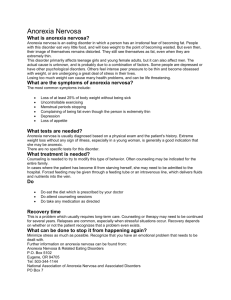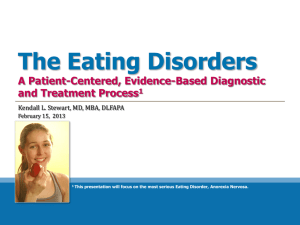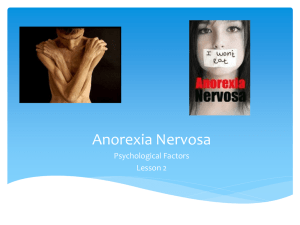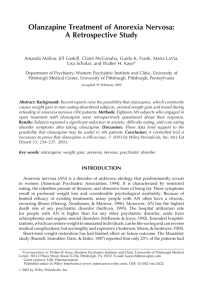Case Reports of Olanzapine Treatment of Anorexia Nervosa
advertisement
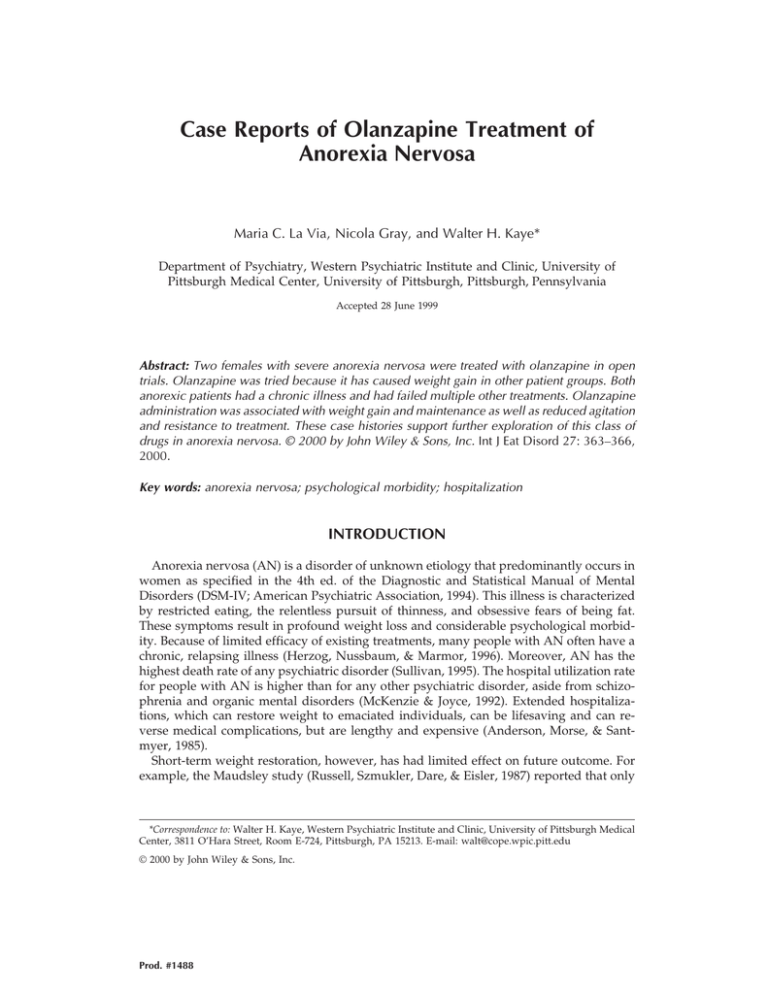
Case Reports of Olanzapine Treatment of Anorexia Nervosa Maria C. La Via, Nicola Gray, and Walter H. Kaye* Department of Psychiatry, Western Psychiatric Institute and Clinic, University of Pittsburgh Medical Center, University of Pittsburgh, Pittsburgh, Pennsylvania Accepted 28 June 1999 Abstract: Two females with severe anorexia nervosa were treated with olanzapine in open trials. Olanzapine was tried because it has caused weight gain in other patient groups. Both anorexic patients had a chronic illness and had failed multiple other treatments. Olanzapine administration was associated with weight gain and maintenance as well as reduced agitation and resistance to treatment. These case histories support further exploration of this class of drugs in anorexia nervosa. © 2000 by John Wiley & Sons, Inc. Int J Eat Disord 27: 363–366, 2000. Key words: anorexia nervosa; psychological morbidity; hospitalization INTRODUCTION Anorexia nervosa (AN) is a disorder of unknown etiology that predominantly occurs in women as specified in the 4th ed. of the Diagnostic and Statistical Manual of Mental Disorders (DSM-IV; American Psychiatric Association, 1994). This illness is characterized by restricted eating, the relentless pursuit of thinness, and obsessive fears of being fat. These symptoms result in profound weight loss and considerable psychological morbidity. Because of limited efficacy of existing treatments, many people with AN often have a chronic, relapsing illness (Herzog, Nussbaum, & Marmor, 1996). Moreover, AN has the highest death rate of any psychiatric disorder (Sullivan, 1995). The hospital utilization rate for people with AN is higher than for any other psychiatric disorder, aside from schizophrenia and organic mental disorders (McKenzie & Joyce, 1992). Extended hospitalizations, which can restore weight to emaciated individuals, can be lifesaving and can reverse medical complications, but are lengthy and expensive (Anderson, Morse, & Santmyer, 1985). Short-term weight restoration, however, has had limited effect on future outcome. For example, the Maudsley study (Russell, Szmukler, Dare, & Eisler, 1987) reported that only *Correspondence to: Walter H. Kaye, Western Psychiatric Institute and Clinic, University of Pittsburgh Medical Center, 3811 O’Hara Street, Room E-724, Pittsburgh, PA 15213. E-mail: walt@cope.wpic.pitt.edu © 2000 by John Wiley & Sons, Inc. Prod. #1488 364 La Via, Gray, and Kaye 23% of the patients had a good outcome at 1 year after being hospitalized for weight restoration. This is because pharmacologic and psychologic treatments for AN have been of limited efficacy. For example, pharmacologic treatments (antidepressants including selective serotonin reuptake inhibitors [SSRIs] and neuroleptics) that have focused on increasing weight and reducing symptoms in emaciated patients have had little success (Hoffman & Halmi, 1993). Our group has found (Kaye et al., in press) that fluoxetine, in a controlled trial, prevented relapse and reduced obsessionality and depression when administered after weight restoration in women with AN. However, recent limitations of health care coverage have resulted in shorter lengths of inpatient treatment for patients with AN (Silber, 1994). Thus, anorexics are often discharged while still underweight. In consideration of other pharamacologic treatments for AN is the fact that administration of the atypical neuroleptics is often associated with weight gain as a side effect. Weight gain is most significant with clozapine, but it is also well documented with risperidone, sertindole, and olanzapine. Patients in studies with these latter three drugs have gained, on average, approximately 2–8 lb (1–4 kg) over the first 6–8 weeks of study. Longer-term treatment studies have shown that some patients continue to gain several more pounds before their weight stabilizes (Casey, 1996). Of the atypical neuroleptic agents, olanzapine has the most favorable side effect profile (Reus, 1997). In addition, these drugs may be useful in reducing severe agitation and mood lability. These properties led us to try an open-label trial of olanzapine in several particularly agitated and resistant underweight AN patients. CASE DESCRIPTIONS Case 1 is a 15-year-old single white female with a 5-year history of AN, purging type. During the past 5 years, she had spent an average of 9 months in the hospital per year. She presented for admission to our inpatient eating disorders unit at 37 lb (16.9 kg; 46% average body weight [ABW]) with several related medical complications. She had a previous trial of another neuroleptic, Haldol; however, this was discontinued because she experienced a dystonic reaction. During the course of this hospitalization, she was started on olanzapine, initially 2.5 mg HS, as we wanted to determine whether it would reduce agitation and lability. She reported only mild sedation and a reduction in agitation and anxiety. The olanzapine was gradually increased to 5 mg twice a day with continued reports of improvement and decreased complaints of sedation. She was able to gain weight during the course of this 14-week hospitalization. At the time of discharge her weight was 74 lb (33.7 kg; 92% ABW). This is an average weight gain of 3 lb (1.2 kg ) per week (3.3% ABW weight gain per week). She continued on the olanzapine and was able to maintain her weight above 86% ABW for the next 6 months. During that time, the olanzapine was increased to 5 mg every morning and 10 mg every HS. After 6 months, she was rehospitalized because of an increase in purging behaviors that was associated with returning to school. However, she had been able to maintain a relatively normal body weight (69 lb [31.5 kg] or 86% ABW) on the olanzapine. Case 2 is a 27-year-old divorced white female with a 6-year history of AN, purging type, and multiple previous psychiatric hospitalizations for the treatment of her eating disorder. She was 106 lb (48 kg; 80% ABW) on admission. In the past, she had been unable to maintain her weight within a normal weight range despite several medication trials and intense outpatient therapy. She was started on olanzapine 5 mg at HS for impulsivity, Olanzapine Treatment 365 lability, and paranoid symptoms. She tolerated olanzapine well with initial complaints of feeling slightly sedated, which gradually resolved. The olanzapine was increased to 10 mg at HS to target continued symptoms. During the course of a 22-day hospitalization, she was able to gain a total of 12 lb (5.3 kg) and was discharged at 117 lb (53.3 kg; 89% ABW). This is an average weight gain of 4 lb (1.7 kg) per week. She continued on the olanzapine after discharge and has been able to maintain her weight for the past 4 months. COMMENT These 2 patients have been among the most difficult patients we have treated in our program. Both had chronic AN with repeated hospitalizations. They were particularly resistant, agitated patients who had a long history of difficulty with eating and gaining weight as well as with maintaining weight after discharge. In both cases, olanzapine treatment was associated with an improvement in compliance with refeeding and weight gain as well as postdischarge weight maintenance. In addition, both patients had a substantial reduction in agitation and resistant core eating-disordered behaviors. There have been a few controlled trials of neuroleptic treatment in AN. An early open trial suggested a potential benefit of chlorpromazine (Dally & Sargant, 1960). A doubleblind crossover study showed a nonsignificant trend for pimozide for more rapid weight gain in a 3-week trial (Vandereycken & Peirloot, 1982). A double-blind crossover study showed that sulpride was associated with a nonsignificant trend toward improved weight gain in hospitalized anorexic patients (Vandereycken, 1984). If olanzapine proves to be effective in underweight anorexics, what might be its mode of action? The studies cited above might suggest that drugs with dopaminergic activity are not useful in AN. The effects of olanzapine on weight and appetite and other behavioral symptoms could be related to 5-HT2 receptor blockade. Considerable data in animals and humans show that treatments that increase intrasynaptic serotonin (5-HT) or activate 5-HT receptors tend to reduce food consumption (Blundell & Hill, 1992). Conversely, interventions that diminish 5-HT neurotransmission increase food consumption and promote weight gain (Leibowitz, 1990). Theoretically, food restriction, which is a core symptom of AN, could be related to increased 5-HT activity, such as an upregulation of postsynaptic 5-HT2 receptors. Disturbances of 5-HT activity have also been implicated in other symptoms that are common in AN such as obsessionality (Barr, Goodman, Price, McDougle, & Charney, 1992), anxiety (Charney, Wood, Krystal, & Heninger, 1990), and depression (Grahame-Smith, 1992). In summary, these case studies support the rationale for further studies of olanzapine and other atypical antipsychotic medications in patients with AN. REFERENCES American Psychiatric Association. (1994). Diagnostic and statistical manual of mental disorders (4th ed.). Washington, DC: Author. Anderson, A.E., Morse, C.L., & Santmyer, K.S. (1985). Inpatient treatment for anorexia nervosa. In D.M. Garner & P.E. Garfinkel (Eds.), Anorexia nerovsa and bulimia (pp. 311–343). New York: Guilford. Barr, L.C., Goodman, W.K., Price, L.H., McDougle, C.J., & Charney D.S. (1992). The serotonin hypothesis of obsessive compulsive disorder: Implications of pharmacologic challenge studies. Journal of Clinical Psychiatry, 53 (Suppl. 4), 17–28. 366 La Via, Gray, and Kaye Blundell, J.E., & Hill, A.J. (1992). Dexfenfluramine and appetite in humans. International Journal of Obesity, 16, S51–S59. Casey, D.E. (1996). Side effect profiles of new antipsychotics. Journal of Clinical Psychiatry, 57 (Suppl. 11), 38–45. Charney, D.S., Wood, S.W., Krystal, J.H., & Heninger, G.R. (1990). Serotonin function and human anxiety disorders. Annals of the New York Academy of Science, 600, 558–573. Dally, P.J., & Sargant, W. (1960). A new treatment of anorexia nervosa. British Medical Journal, 1, 1770–1773. Grahame-Smith, D.G. (1992). Serotonin in affective disorders. International Clinical Psychopharmacology, 6, S5–S13. Herzog, D.B., Nussbaum, K.M., & Marmor, A.K. (1996). Comorbidity and outcome in eating disorders. Psychiatric Clinics of North America, 19, 943–954. Hoffman, L., & Halmi, K. (1993). Psychopharmacology in the treatment of anorexia nervosa and bulimia nervosa. Psychiatric Clinics of North America, 16, 767–778. Kaye, W.H., Nagata, T., Weltzin, T.E., Hsu, L.K.G., Sokol, M.S., McConaha, C., Plotnicov, K.H., Weise, J., & Deep, D. (in press). Double-blind placebo-controlled administration of fluoxetine in restricting-type anorexia nervosa. American Journal of Psychiatry. Leibowitz, S.F. (1990). The role of serotonin in eating disorders. Drugs, 39, 895–903. McKenzie, J.M., & Joyce, P.R. (1992). Hospitalization for anorexia nervosa. International Journal of Eating Disorders, 11, 235–241. Reus, V.I. (1997). Olanzapine: A novel atypical neuroleptic agent. Lancet, 349, 1264–1265. Russell, G.F.M., Szmukler, G.I., Dare, C., & Eisler, I. (1987). An evaluation of family therapy in anorexia nervosa and bulimia nervosa. Archives of General Psychiatry, 44, 1047–1056. Silber, T.J. (1994). Eating disorders and health insurance. Archives of Pediatric Adolescent Medicine, 148, 785–788. Sullivan, P.F. (1995). Mortality in anorexia nervosa. American Journal of Psychiatry, 152, 1073–1074. Vandereycken, W. (1984). Neuroleptics in the short-term treatment of anorexia nervosa: A double-blind placebocontrolled trial with sulpride. British Journal of Psychiatry, 144, 288–292. Vandereycken, W., & Peirloot, R. (1982). Pimozide combined with behavior therapy in the short-term treatment of anorexia nervosa: A double-blind, placebo-controlled, cross-over study. Acta Psychiatrica Scandinavica, 66, 445–450.

